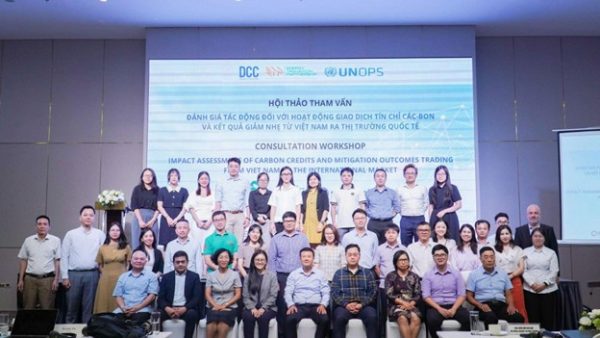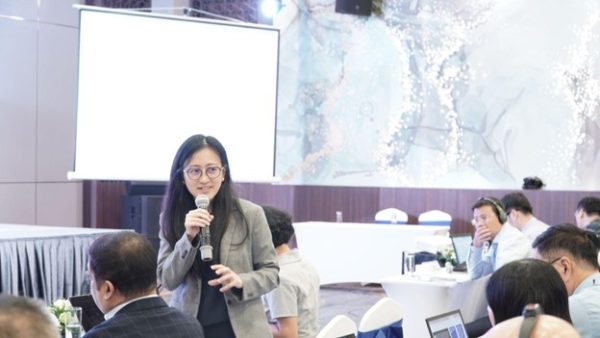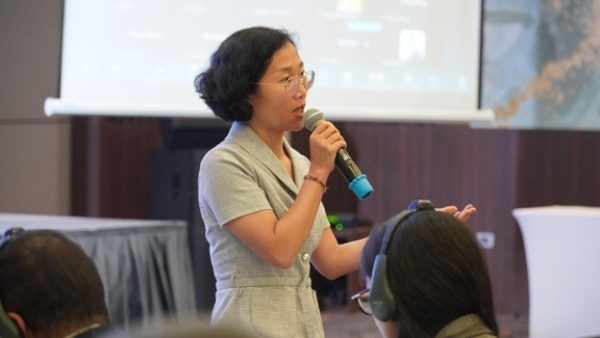On August 20, 2025, in Hanoi, Energy and Environment Consultancy Joint Stock Company (VNEEC), in collaboration with Green Climate Innovation Co., Ltd. and South Pole Group, organized a consultation workshop titled “Impact Assessment of Carbon Credits and Mitigation Outcomes Trading from Vietnam to the International Markets.” This consultation workshop was held under the Technical Assistance Program “Impact Assessment of the Greenhouse Gas Emission Trading System and Carbon Credits in Vietnam,” funded by the United Nations Office for Project Services (UNOPS) through the Southeast Asia Energy Transition Partnership (ETP), to support the Department of Climate Change (DCC), Ministry of Agriculture and Environment (MAE), in developing Vietnam’s carbon market.
The event attracted the interest of more than 100 delegates attending both in person and online, including leaders of the DCC, MAE, representatives from the Ministry of Finance, Ministry of Construction, the Vietnam Chamber of Commerce and Industry, international organizations, universities, research institutes, representatives of major emitting enterprises, consultants on carbon credit project development, and organizations facilitating international carbon credit transactions.

Photo: Delegates attending the workshop
In his opening remarks, Mr. Nguyen Tuan Quang, Deputy Director General of the Department of Climate Change, stated that the legal framework for the carbon market has been gradually improved. The Law on Environmental Protection 2020, for the first time, introduced regulations on “Organization and Development of the Carbon Market” in Article 139. Subsequently, the Government issued Decree No. 06/2022/ND-CP, amended and supplemented by Decree No. 119/2025/ND-CP, setting out a clear roadmap for carbon market development, with a pilot phase from now until the end of 2028 and official operation from 2029, targeting the launch of a pilot carbon exchange platform as early as 2025. The Prime Minister approved the Scheme on “Establishment and Development of the Carbon Market in Vietnam,” which concretized key tasks and solutions to put the carbon market into operation as scheduled. Regarding international cooperation, the Ministry of Agriculture and Environment is leading and coordinating with relevant ministries and agencies to develop a draft Government Decree on international transfer of greenhouse gas mitigation outcomes and carbon credits, expected to be submitted to the Government in 2025. The roadmap includes piloting until the end of 2028 and officially operating from 2029.

Mr. Nguyen Tuan Quang, Deputy Director General of DCC
Over the past period, the UNOPS Office, through the ETP program, has provided technical assistance to the DCC in assessing the impacts of the emission trading system and carbon credits. The research results serve as an important basis for the MAE to finalize the draft Decree.
Representing the donor, Mr. John Robert Cotton, Deputy Director of ETP, emphasized the role of the carbon market as an important tool in responding to climate change, from the Clean Development Mechanism under the Kyoto Protocol to mechanisms under the Paris Agreement. Currently, more than 70 carbon pricing initiatives have been implemented or are under development worldwide, covering nearly one-quarter of global greenhouse gas emissions.
Mr. John highlighted that participating in international carbon trading is not only about compliance but also an opportunity for Vietnam to mobilize climate finance, promote technology transfer, and move towards the net-zero target by 2050.
At the workshop, Mr. Nguyen Thanh Cong, Deputy Head of the Carbon Market Division, representing the DCC, updated participants on regulations and the roadmap for trading mitigation outcomes and carbon credits. He stated that the draft regulations on international transfer of mitigation outcomes and carbon credits are being developed to govern international exchanges between Vietnam and international partners. According to the draft, international transfer regulations will cover key mechanisms: under Article 6.2 and outside Article 6.2 (including Article 6.4 programs/projects and independent carbon standard programs/projects). The draft also outlines provisions regarding responsibilities for international transfers and corresponding adjustments.
Ms. Roxanne Tan, International Carbon Market Expert at South Pole Group, shared international experiences in carbon credit management, drawing important lessons for Vietnam as it engages in this market. She stressed that a strong management framework must ensure transparency, predictability, and close alignment with NDC targets, while optimizing economic benefits from carbon credits. Drawing on international case studies from countries such as Ghana, Rwanda, Thailand, Cambodia, and Chile, these nations have implemented Article 6 management approaches such as: building legal frameworks for Article 6, establishing registry systems, leveraging existing crediting standards, identifying eligible activities, applying partial mitigation retention to avoid overselling, and, in some cases, imposing corresponding adjustment (CA) fees or benefit-sharing for mitigation, adaptation, and sustainable development efforts. Ms. Roxanne also pointed out that international demand for carbon credits is rapidly increasing, from governments, businesses, and airlines under CORSIA, opening significant opportunities for Vietnam. However, to seize these opportunities, Vietnam needs to promptly identify eligible activity portfolios, determine the proportion of mitigation outcomes retained for domestic NDC implementation, set corresponding adjustment fees, and establish a long-term strategy beyond 2030 to ensure financial feasibility and attract investment. A transparent, clear, and stable management mechanism will be key to enhancing investor confidence, defining the value of Vietnam’s credits in the global market, and contributing to the Net Zero commitment by 2050.

Ms. Roxanne Tan, International Carbon Market Expert, representing South Pole
Ms. Nguyen Hong Loan, Project Team Leader/Climate Policy Expert at Green Climate Innovators Co., Ltd., presented options for managing the trading of carbon credits and mitigation outcomes from Vietnam to international markets.

Ms. Nguyen Hong Loan, Director of Green Climate Innovators Co., Ltd., Project Team Leader, Climate Policy Expert
Accordingly, the study developed and assessed nine scenarios based on two main factors: the portfolio of eligible activities approved for international transfer and the proportion of mitigation outcomes retained to ensure the achievement of national NDC targets. In terms of supply, the study examined two options: (i) the S20 scenario, which allows trading of credits generated only from 20 mitigation measures that fully contribute to conditional NDC targets; and (ii) the S56 scenario, which expands the scope to 56 mitigation measures contributing to both conditional and unconditional NDC targets. Correspondingly, the trading limits were set at 90% for the S20 scenario, and at two levels – 70% or 50% – for the S56 scenario, in order to manage the risk of overselling and to safeguard the achievement of national NDC objectives. Price was identified as one of the key factors influencing the impact assessment of these scenarios. Price ranges were divided into three bands- high, medium, and low – corresponding to different buyer groups. These price bands were illustrated in tables and charts to clearly reflect potential market fluctuations.
In addition, other important factors, such as buyer prioritization, tax regimes, and transaction fees, were incorporated into each scenario. Specifically, the study applied a prioritization mechanism for purchasing credits based on the level of partnership (for example, partners with cooperation agreements were given priority) and market demand (such as CORSIA), combined with the three price bands (low, medium, high) for each buyer group to reflect market volatility. At the same time, financial elements such as a 20% corporate income tax, 10% value-added tax (VAT), and a 2% transaction fee on total revenue were integrated to provide a comprehensive impact evaluation.
Regarding the results of the impact assessment, Mr. Ho Cong Hoa, Impact Assessment Expert at the Academy of Policy and Development, stated: “Economic and social benefits are maximized under the expanded portfolio scenario S56, which is eligible for international transfer approval. Under this scenario, economic benefits from carbon credit trading could contribute an average of 0.43% annually during the 2025–2030 period, while also boosting investment, consumption, and job creation.”
Mr. Hoa emphasized that expanding international trading also carries the risk of “overselling.” Therefore, it is necessary to establish trading caps to ensure the requirements for corresponding adjustments under the Paris Agreement and to contribute to Vietnam’s NDC goals. If 50% of credits are retained, Vietnam could secure up to 62% of its unconditional NDC target; whereas retaining 30% would correspond to a contribution of 37.3%.

Mr. Ho Cong Hoa, Impact Assessment Expert, Academy of Policy and Development
Experts also recommended that Vietnam adopt a phased approach, starting with a cautious trading cap of 50%. As domestic greenhouse gas mitigation capacity strengthens and confidence in achieving unconditional targets increases, the trading cap could be raised to 70% to fully realize conditional NDC targets with international support. In addition, a reasonable transaction fee of about 2% should be applied to increase state budget revenue from the carbon market. This revenue should be reinvested into hard-to-abate sectors such as agriculture and forestry to ensure fairness and enhance overall mitigation effectiveness.
Furthermore, policies encouraging businesses to invest in credit-generating measures in priority sectors should be considered to maximize contributions to NDC targets while mitigating price volatility risks, thereby enhancing the competitiveness of Vietnamese carbon credits in international trading.
2,676 views, 2

Tags:
Bài viết liên quan